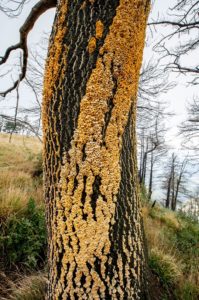TRAMETES VERSICOLOR
Trametes versicolor
Small ubiquitous decomposer fungus that grows on trunks and branches mainly of deciduous trees in autumn and winter. It has a rounded fan shape with a thin lamellar structure and often several carpophores with concentric growth are observed. On the hat there are a series of concentric alternating stripes of different shades from dark to light with blue, green, brown, ocher, gray and orange colors.
– Trametes versicolor acts as a “rebalancer” on the immune system often altered by diseases, stress, incorrect diet, chemicals and pollution. The imbalance usually elevates the Th2 cytokinins, leads to an inflammatory state with a partial inability of the organism to respond. The fungus stimulates Th1 cytokinins that inhibit Th2 ones, managing to bring the system back into balance. Its immunomodulating property is also expressed by the increase of NK lymphocytes which are stimulated both in number and in cytotoxic function. Trametes versicolor is useful for fighting chronic degenerative viral diseases such as hepatitis C and HIV. The intake of the mushroom reduces the symptoms of Herpes simplex and has shown efficacy in negativizing the human papilloma virus (HPV) with a decrease in the cancerous tendency of the lesions. In addition, good results have been found in the treatment of chronic fatigue syndrome (CFS) and infections of the respiratory, urinary and digestive systems.
– In the second half of the sixties, a Japanese pharmaceutical company obtained an extract from the carpophore and mycelium called PSK. It is a glycoprotein with a mixture of polysaccharides that was marketed as Krestin; became a real anticancer drug, used as an adjuvant in traditional therapies and approved by the Japanese Ministry of Health. In 1983 another extract from the deep layers of the mycelium, called PSP, was isolated in China. In 1992 it was approved as a class I drug by the Chinese Ministry of Health and has been on the list of reimbursable drugs by the state since 1999. There are many clinical studies carried out on guinea pigs, on in vitro cells and on cancer patients in different stages of development of the disease. The antitumor action is due both to the stimulation of the immune system and to the direct action to hinder the synthesis of DNA in cancer cells with an inhibition to the formation of metastases. It has proved capable of reducing the side effects of chemotherapy and this mushroom is prescribed in the East immediately after the diagnosis of the disease in order to be able to have a useful time to be able to act and prepare the way for conventional therapies. It is also able to prevent drug-induced carcinogenesis and radiotherapy. The antioxidant properties are such as to block free radicals such as hydroxyl and superoxide which can cause serious damage to cells with the risk of gene mutations. The antineoplastic action of Trametes versicolor is particularly effective for virus-induced and hormone-dependent tumors, side effects have never been found and it can be taken for a long time. Here are some example studies related to PSK and PSP extracts. In a study conducted on 185 patients with stage I, II and III lung cancer, all undergoing radiotherapy with the intake of Trametes versicolor extract for half of them, led to the following results: after 10 years, the 39% of the stage I and II patients who received the extract were still alive, compared with 16% in the other group. Furthermore, the survival rate in stage III patients was 22% in the first group and 5% in the second group. In a study conducted on 227 women with breast cancer treated with chemotherapy and with the addition of the extract of the mushroom for some of them, it allowed to obtain survival after 10 years for 81.1% of the group that took also the mushroom, compared to 64.5% of the other group. A study was conducted on 262 patients with gastric cancer who had a gastrectomy with subsequent chemotherapy. The group that also took the mushroom, after 5 years managed to survive in 73% of cases, compared to 60% survival in the group with only chemotherapy. Other studies have been conducted to verify the ability of Trametes versicolor to reduce the side effects of chemotherapy and radiotherapy with consistently positive results.
BIBLIOGRAPHY
1 – Ardigò W. Mycotherapy for all. 2015, Rotomail Italy.
2 – Bianchi I. Healing with medicinal mushrooms Therapeutic properties and instructions for use of the 12 most important medicinal mushrooms. 2015, Editorial Program
3 – Bianchi V. Medicinal mushrooms To live long in perfect health. 2009, The Age of Aquarius.
4 – Cazzavillan S. Medicinal mushrooms from tradition to science. 2011, Nuova Ipsa Editore.
5 – Cazzavillan S. Cordyceps sinensis Fountain of youth. 2014, Nuova Ipsa Editore.
6 – Cazzavillan S. Ganoderma lucidum Reishi or Ling zhi The heart fungus. 2015, Nuova Ipsa Editore.
7 – Cotter T. Organic Mushroom Farming and Mycoremediation Simple to Advanced and Experimental Techniques for Indoor and Outdoor Cultivation. 2014, Chelsea Green Publishing.
8 – Ferri F. et al. Mushrooms Cultivation and medicinal properties. 2007, Edagricole.
9 – Halpern GM Mushrooms that heal. 2013, Il Punto d’Incontro Editions.
10 – Kenneth J. Shiitake The Healing Mushroom. 1995, Healing Arts Press.
11 – Powell M. Medicinal Mushrooms A Clinical Guide. 2010, Mycology Press.
12 – Schulten FD Reishi. The mushroom of immortality An extraordinary remedy with miraculous therapeutic properties. 2007, Editions Il Punto d’Incontro.
13 – Stamets P. Growing gourmet & medicinal mushrooms. 1993, Ten Speed Press.
14 – Stamets P. Chilton JS The mushroom cultivator A pratical guide to growing mushroom at home. 1983, Agarikon Press.
15 – Stamets P. Wu Yao C. Dusty, MycoMedicinals An informational booklet on medicinal mushrooms. 2002, MycoMedia a division of Fungi Perfecti.








